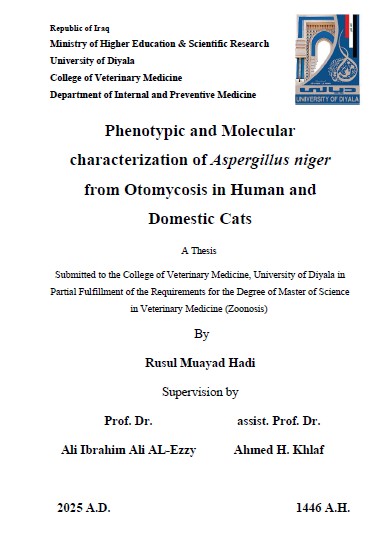Abstract
aspergillus spp. Is a saprophytic opportunistic fungal pathogen that causes otomycosis in humans. Some fungal illnesses linked to zoonotic transmission are overlooked in public health efforts, necessitating the development of additional preventative techniques.
The study aims to Isolate Aspergillus niger from external ear of cats and their owners, Molecular characterization of A. niger by Conventional PCR, study the clinical manifestations for human and cats, detection of putative risk factors for infection with aspergillus in human and cats, detection of fumonisin and ochratoxin by PCR.
One hundred and six from the external ear swabs were taken from Domestic Cats attended to private veterinary clinics and cultured on Sabouraud dextrose agar. Fungal growth was identified as A. niger according to cultural characteristics. All A. niger positive samples were subjected to confirmatory step by conventional PCR using species-specific PCR primer pairs for A. niger (NIG1) and (Cmd A). Production of fumonisin and ochratoxin by A. niger confirmed by using specific primers.
A. niger was isolated from 11/106, (10.38%) ear swabs of Domestic Cats Breeders. All A. niger positive samples were positive in confirmatory step by conventional PCR using species-specific PCR primers for A. niger, (NIG1) and (Cmd A).
Swabs frequently were taken from ear of Domestic Cats Breeders at the age group (41-48) years, 24/106(22.64%) in which A. niger was isolated from 3/106, (2.83%). Significant correlation was reported between age group and isolation of A. niger. No significant correlation was recorded between sex, education levels, economic status and infection with A. niger.
Among cat breeders most cases were presented in autumn from ear of Domestic Cats Breeders, 60/106, (56.6%) compared with 46/106 (43.39%) in winter. A. niger was isolated frequently in winter from ear of Domestic Cats Breeders, 8/106, (7.54%) compared with 3/106 (2.83%) in autumn. Significant correlation (p value=0.038) was reported between season and isolation of A. niger.
A. niger was isolated frequently from ear of Domestic Cats Breeders, suffering from absence of earwax 7/106 (6.60%), compared with 4/106 4(3.77%), do not suffering from absence of earwax. Significant difference, (p value=0.000) and correlation (p value=0.024) were reported between absence of earwax and isolation of A. niger. A. niger was isolated from breeders whom practice swimming, 7/106, (6.60%), compared with 4/106, (3.77%) they do not practice swimming. No significant difference nor correlation were reported between swimming, and isolation of A. niger
A. niger was isolated mainly from breeders do not use of antibiotics eardrops, 7/106 (6.60%) compared with 4/106 (3.77%) from those using antibiotics eardrops. Significant difference (p value= 0.002) and correlation (p value= 0.013) were reported between using of Antibiotics eardrops and isolation of A. niger.
A. niger was isolated mainly from breeders do not expose to trauma of the external ear canal, 10/106 (9.43%) compared with 1/106 (0.94%) from those exposed to trauma. No significant difference (p value = 0.747) nor correlation (p value= 0.245) were reported between exposure to trauma and isolation of A. niger. No significant difference (p value = 0.095) no correlation (p value= 0.881) were reported between DM and isolation of A. niger.
A. niger was isolated equally from public workers, Free workers and housewives 3/106, (2.83%). No significant difference (p value= 0.526) nor correlation (p value = 0.882) were reported between occupation and isolation of A. niger. No significant correlation was reported between unilateral facial swelling; Nasal congestion; Sinus congestion and pain; Cough; dyspnea; pain around the eyes and isolation of A. niger from Domestic Cats Breeders ear. Significant correlation was reported between chest pain; dizziness; tinnitus; ear itching and isolation of A. niger from ear of Domestic Cats Breeders.
A. niger was completely resistant to Ketoconazole and Fluconazole (11/11,100%). A total of 7/11 A. niger, (63.63%) were resistant to Itraconazole compared to 4/11, (36.36%) have intermediate zone of inhibition (14-18mm). Nystatin represents potent antifungal agent against A. niger with minimum zone of inhibition (17mm). A total of 9/11, (81.81%) of A. niger were susceptible to Nystatin and 2/9, (18.18%) have intermediate zone of inhibition (14-18mm). A total of 2/11, (18.18%) of A. niger were susceptible to Miconazole and 8/11, (72.72%) have Intermediate zone of inhibition (14-18mm) and only1/11, A. niger isolate, (9.09%) was resistant (<14 mm).
Fumonisin was detected in 7/11(63.64%) of A. niger isolated from ear of Domestic Cats Breeders. Ochratoxin was not produced by any isolates of A. niger, 0/11, (0%)
The total number of A. niger isolated from ear of Domestic Cats was 22/106, (20.75 %) All A. niger positive samples were subjected to confirmatory step by conventional PCR using species-specific PCR primer pairs for A. niger (NIG1) gene length 290 bp guaranteed to be A. niger
and (Cmd A) gene length 245 bp guaranteed to be A. niger.
In current study, cats with age (2-6) months were frequently infected with A. niger 8/106, (7.54%) followed by those with (12- 16) months 7/106, (6.60%). A. niger was not recover from old age, (17-21) months, (27-31) months. No significant difference nor correlation were reported between age of Domestic Cats and infection with A. niger.
Current study revealed that 66/106 of Domestic Cats were males (62.26%) while female represent 40/106 (37.73%). A total of 16/106 (15.09%) males were infected with A. niger isolated from ear versus 6/106(5.66%) for females. No significant correlation was reported between sex of Domestic Cats and infection with A. niger. Females appear to be at risk of getting A. niger infection at (1.813) time than males.
No significant correlation was reported between body weight; breed; hair length; ear cleaning interval; Bathing frequency of Domestic Cats; Season and infection with A. niger.
No significant correlation was recorded between head shaking; head tilting; rubbing against wall; ulcers around the nostrils; malodorous; unilateral ear drooping; lethargy; sneezing and isolation of A. niger. Significant correlation was recorded between Blackish waxy discharge of ear; Erythematous lesion of ear and isolation of A. niger, (p value=0.012).
A. niger was completely resistant to Ketoconazole and Fluconazole (22/22,100%) with minimum zone of inhibition, (0mm). A. niger was resistant to Itraconazole which is the second antifungal agent in the scale, with minimum zone of inhibition for A. niger, 10mm. A total of 20/22, (90.90%), A. niger were resistant to Itraconazole compared to 2/22, (9.09%) have intermediate zone of inhibition (14-18mm). Nystatin represents potent antifungal agent against A. niger with minimum zone of inhibition (15mm). A total of 15/22, (68.18%) of A. niger were susceptible to Nystatin and 7/22, (31.81%), have intermediate zone of inhibition (14-18mm).
Miconazole minimum zone of inhibition (10 mm). A total of 17/22, (77.27%) of A. niger have Intermediate zone of inhibition (14-18mm) and only5/22, (22.27%), A. niger isolate have resistant (<14 mm).
Fumonisin was detected in 7/17(41.17%) of A. niger isolated from ear of Domestic Cats. Ochratoxin was not produced by any isolates of A. niger, 0/17, (0%).




